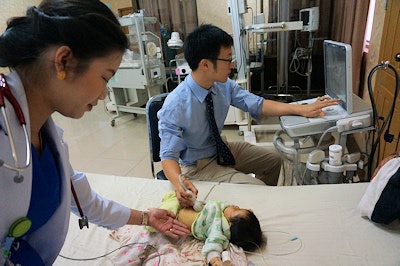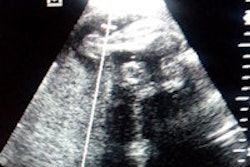
With so many other pressing healthcare priorities, resource-strapped hospitals in developing countries may consider PACS to be out of their reach. But if the experience of one Laotian hospital is any indication, it may be well worth the investment.
A year after implementing PACS, Children's Hospital of Lao People's Democratic Republic (PDR) found that imaging tests -- previously underutilized -- had increased by more than 70%. This suggests an indirect benefit of improved quality of care, according to the group led by Dr. In-Chang Hwang, now a clinical fellow in the department of cardiology at Seoul National University Hospital in Korea.
 Dr. In-Chang Hwang, now a clinical fellow at Seoul National University Hospital.
Dr. In-Chang Hwang, now a clinical fellow at Seoul National University Hospital."We showed that potential benefit of PACS for quality of care can be realized even in resource-limited settings," they wrote in the October issue of the International Journal of Medical Informatics (Vol. 94:10, pp. 31-38).
Challenging conditions
Prior to adopting PACS, the Children's Hospital of PDR, a 70-bed national pediatric referral hospital in the prefecture of Vientiane, distributed the results of imaging studies to patients but did not store these results at the hospital. The institution did write down patient information in ledgers, but only to count the number of patients.
"Therefore, damage to and loss of imaging test results were inevitable, and follow-up of patients' clinical courses were not possible," they wrote. "Adding to the difficulty of the utilization of imaging tests was the fact that inexperienced radiography technicians often produced poor-quality x-ray films that were not adequate for interpretation because of radiation exposures that were too low or high."
Many physicians also had limited knowledge and experience with radiology, a shortcoming that further hampered the hospital's ability to provide quality care, according to the authors.
As a result, the group sought to bring PACS to the hospital with the goal of enabling the systematic utilization of imaging studies and improving the hospital staff's capabilities in radiology. They had a budget of $53,397, which included grant money from the Korea International Cooperation Agency (KOICA). The project was managed by a task force consisting of six local physicians, two radiography technicians, and two computer technicians from the hospital, as well as a medical doctor, radiography technician, and a computer/IT technician from the KOICA.
 Echocardiography study performed at Children's Hospital of Lao People's Democratic Republic. Image courtesy of Dr. In-Chang Hwang.
Echocardiography study performed at Children's Hospital of Lao People's Democratic Republic. Image courtesy of Dr. In-Chang Hwang.Because its PACS would be the first in the nation and other hospitals were using film-based practices, the institution elected to implement PACS software (ZeroPACS, Dimedi) along with a film scanner (DMD D-2000, Dimedi). The radiology department housed the main server room, while DICOM image conversion gateways were placed in both the x-ray and ultrasound rooms. The ultrasound scanners, which included an Accuvix V10 echocardiography system (Samsung Medison) and a Viamo system (Toshiba Medical Systems), were connected directly to the main server, according to the team.
In addition, PACS viewing software was installed at 20 locations throughout the hospital, including in the outpatient hospital department medical ward, emergency room, intensive care unit, and operating room. Installation was completed in December 2014 and maintenance and education were provided for five months afterward, according to the group.
Increased utilization
In the year after installing PACS, the hospital experienced a nearly 20% increase in the number of imaging tests it performed each month, even while it had a lower mean number of patients:
- Pre-PACS: 225.8 ± 37.7 imaging exams per month
- Post-PACS: 269.4 ± 38.5 imaging exams per month
The difference was statistically significant (p = 0.0103), according to the researchers.
| Utilization rate of imaging tests per total No. of patients | ||||
| Pre-PACS (December 2013 to November 2014) | Post-PACS (December 2014 to November 2015) | Increase | p-value | |
| X-ray | 1.65 ± 0.32% per month | 2.38 ± 0.52% per month | 44% | 0.0004 |
| Ultrasound (including echo) | 0.82 ± 0.24% per month | 1.85 ± 0.59% per month | 125% | 0.0001 |
| Total imaging studies | 2.47 ± 0.32% per month | 4.23 ± 0.89% per month | 71.3% | < 0.0001 |
"Given the significant increase in utilization rate of imaging tests and potential benefit from it, our results would help facilitate the distribution of PACS in developing countries," they wrote.
The authors noted that the PACS was implemented based on the needs and capabilities of the local staff members, who actively participated in the project.
"Further, the follow-up education programs, which included lectures by local radiology staff and one-on-one teaching sessions for hospital staff, may be one of the most important reasons for the improved utilization of medical imaging tests," the authors wrote. "The education programs included not only the use of PACS but also basic knowledge for the interpretation of radiologic images because some of the local physicians were not familiar with the imaging tests. Regular lectures and one-on-one teaching sessions were provided for hospital staff in each department in which the PACS was installed, using real-practice examples in their clinical field according to normal workflow patterns."
A crucial benefit
The quantifiable benefit of improved imaging utilization is critical for many developing countries, where the only diagnostic tools may be a physical examination and taking the patient's history, according to the researchers.
"Imaging tests add essential information to [the] clinical reasoning process and differentiate several disease conditions, finally [resulting] in the improvement of quality care," they wrote. "This benefit of PACS would be unique in resource-poor countries, where the overall medical environment is at [an] early stage of progress."
The researchers acknowledged that an increase in utilization may not necessarily demonstrate an improvement in quality of care; that would need to be assessed by patient interviews, changes in hospital stay or turnaround time, a user satisfaction survey, and error report analysis.
"However, given the significant results of our study, we expect the PACS implementation in the Children's Hospital of Lao PDR would facilitate future improvements in quality of care, when combined with continuous education which was the primary reason for the successful implementation in our experience," they wrote.
The institution's experience can also serve as a practical model for implementing PACS in developing countries.
"As suggested in previous studies, the adoption of appropriate education and training strategies are crucial for successful implementation of PACS, especially in terms of user acceptance, integration into pre-existing workflow, and, most importantly, clinical application and quality of care," they wrote.
They cautioned, however, that that their results might not apply to other developing countries, which may prioritize healthcare budgets for communicable diseases, maternal healthcare, and nutritional disorders. Due to the lack of infrastructure and high cost of advanced technology and skilled personnel, there could be concern that the potential benefit of PACS would not outweigh the total cost of overcoming these barriers.
"Therefore, the implementation of PACS in developing countries should be considered in the context of local environment," they wrote.




















